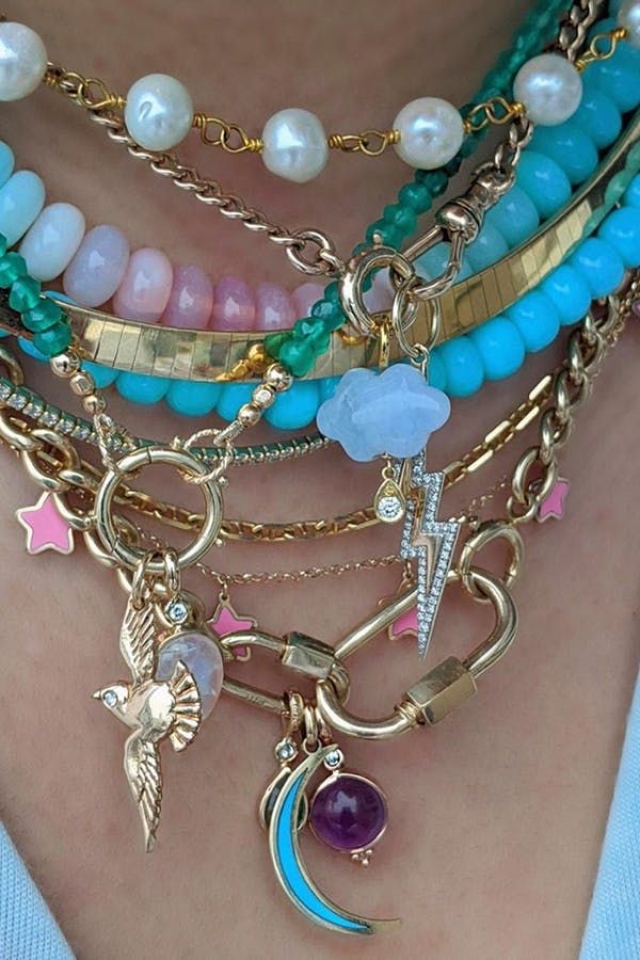African tribal jewelry is an artistic representation of traditional African culture and much like many other cultures, it symbolizes a range of societal norma and values. Ranging from the Zulus in South Africa to the Masai in East Africa, each tribe incorporates a distinct set of jewelry designs which make it easily identifiable. In order to trace the history of African Tribal Jewelry it is essential to look at time before colonization.
African Tribal Jewelry dates back many centuries and was worn for a variety of reasons. It was often used to symbolize status, religion conviction, political position as well as marital status. For example during marriage ceremonies tribe members would adorn themselves with elaborate beaded skirts, necklaces or headpieces that told a story about their journey as adults.
In addition to highlighting the different stages of adulthood this jewelry also served as an expression of individuals’ religious beliefs and even as protective talismans against supernatural harm. As far back as medieval times African people began using beads both for spiritual adornment and for currency exchange between tribes in distant parts of the continent like West Africa and Central Africa.
In more recent times variations within traditional African tribal jewelry have been impacted by European influences that brought new technology such as machinery for metal-smithing, specialized tools and weaving looms which enabled jewelers craft intricate patterns more efficiently than ever before. Furthermore these added benefits combined with access to more materials allowed crafters to create even larger pieces including layered necklaces made from strands up to seven feet long.
This Renaissance era gave birth to generations of tribal artist who crafted spectacular items out silver, gold glass beads which are highly esteemed today not only within traditional communities but also on global markets because its symbolic beauty conveys an old world sentimentality almost no other jewelry can rival.
Regional Differences in African Tribal Jewelry
The intricate jewelry designs and patterns used by African tribes have been developed over hundreds of years. The jewelry is often highly symbolic, with each piece carrying its own story or legend. Although the same kinds of materials are used across the continent, there are major differences in tribal jewelry pieces from region to region. These regional variations reflect a variety of influences, including climate, geography, culture, resources available in the area and access to outside trading contacts.
Northern Africa
In northern Africa, jewelry styles are heavily influenced by Islamic culture and ancient civilizations like the Egyptians and Phoenicians. Gold was particularly prominent here due to its religious and social significance within Arabic cultures. Many pieces also featured intricate designs carved into metal which were often associated with Berber folklore – such as scarab beetles for protection or shooting stars for good luck.
Traditional shapes such as crescents or rings were also popular as symbols of eternity or wealth. Additionally a range of semi-precious stones such as lapis lazuli were widely used in jewelry due to their spiritual significance in Islam and Coptic Orthodoxy.
East African Tribes
The tribes inhabiting east Africa provide some of the most eclectic tribal clothing styles on the continent due to their access to imported fabrics from Europe and India. In contrast with northern African cultures, tribal jewelry here tended to be less elaborate – often just consisting of simple necklaces created entirely from beads arranged by color or texture motifs that reflected important cultural beliefs.
Cycles of life such as birth, death or marriage held special significance among east African tribes and these events would usually be commemorated with some kind of beadwork accessory or symbolic ornamentation worn around the body during rituals.
Central African Cultures
Central African cultures place strong emphasis on physical appearance, resulting in bolder yet more ceremonial designs than those common elsewhere on the continent – headdresses made out of cloth layers edged with colorful baubles being a prime example. This emphasis often extended beyond conventional accessories like necklaces and bracelets; traditional garments resembled outfits highlighted with intricate cuts embroidered in fine metallic threads along every seam while clay images representing tribal deities decorated doorways as blessings for families living inside them.
Central African cultures also integrated animal imagery into many different forms: figures molded from clay symbolized strength and health while large masks carved out of solid wood exemplified spiritual authority over nature itself.
Iconography of African Tribal Jewelry
African tribal jewelry is diverse and distinct, with various tribes making unique pieces that represent different meanings. Some pieces are used to indicate a person’s social status, while others are created to ward off evil spirits. In many cases, the designs have changed over time, but their basic meaning has remained consistent throughout centuries of tradition.
Symbols and Signs
Many African tribal jewelry items feature symbols which can denote certain messages or even convey specific meanings about a person’s heritage or status. Common symbols include animals such as lions and cows, tools such as knives and machetes, and spiritual icons such as rainbows or stars. These symbols are believed to bring luck or protection when worn in the form of jewelry.
Material Elements
The materials used for African tribal jewelry vary depending on the tribe and region of Africa from which they originate. Materials such as ivory, brass, silver, beading and feathers are commonly incorporated into African tribal jewelry pieces along with colorful stones and precious metals like gold. Wooden beads also often feature prominently as decorations in these unique pieces of jewelry.
Types Of Jewelry
Africa is most commonly associated with its beadwork designs which have been prevalent for centuries within the continent’s cultures. However, there are many other types of African tribal jewelry too:
- Collar necklaces
- Bracelets
- Ankle bracelets &belts
- Headpieces
- Earrings & Nose rings
Crafting of African Tribal Jewelry
African tribal jewelry has a rich and varied history, which dates back to pre-colonial times. Historically, African tribes created jewelry for both practical and spiritual purposes. Because of this, the crafting of these pieces involves specific materials and techniques that have been passed down from one generation to the next.
The traditional African tribal jewelry is known for its distinct style and design, with colors and motifs that are unique to each tribe. The pieces often contain a wide variety of natural materials such as wood, leather, bone, stone, shells and metals. These materials are carefully chosen to represent particular meanings based on their symbolism within the tribe or general African culture. In addition to the use of specific materials, tribes employ intricate processes such as:
- Carving
- Engraving
- Riveting
- Stringing
- Weaving
Generally speaking, the more rare or expensive materials are used for high-status jewellery items such as necklaces or earrings. These pieces are often given in exchange for services or goods rendered between tribes members or can also be used for ceremonial purposes such as weddings or funerals. Less elaborate items might include bracelets or anklets with smaller beads made from clay or metal alloys that are cheaper alternatives.
Certain pieces like masks are heavily associated with ritualistic practices bringing mystery to their intended purpose such as protection or prayer in some cultures. For instance, iron forging became a widely practiced skill by many West African cultures during colonial rule due to its ability for crafting weapons essential for defending against forces sent by colonial governments during various wars of resistance in the region.
Today the legacy of African tribal jewelry lives on through modern reproductions crafted by artists around Africa who continue this craft using techniques developed centuries ago combined with new methods and materials making it possible for wider audiences around world enjoy pieces steeped in cultural heritage and significance.
Survival of African Tribal Jewelry
African tribal jewelry has a rich and vibrant history with origins dating back to the Stone Age. It was believed that these ancient techniques and designs were handed down by their ancestors, who used them to express their spiritual beliefs.
Throughout its long history, African tribal jewelry continued to enjoy popularity amongst the continent’s various tribes. In addition to its aesthetic value as a source of beauty and inspiration, it soon came to also denote rank, status, power, and religious symbolism amongst the tribes’ members.
When colonization began in the mid-19th Century, Africans who had been taken from the continent as slaves became exposed to different cultures and societies for the first time. It was during this period that tribal accessories such as necklaces, anklets, bracelets, armrings and more began taking on an added significance – cultural symbols of identification for those who had been so abruptly displaced from home.
The bold aesthetics of African jewelry inspired much of what was created in Europe’s prestigious courts at the time: bright colors; sophisticated designs; elaborate shapes – elements which soon become deeply entwined with many facets of European culture.
Today, African tribal jewelry is still popular in many parts of Africa where it continues to serve an important role in expressions of religious devotion or social pride among it’s people. Simultaneously in western countries such as America and Canada, African tribal jewelry is enjoying a resurgence due largely in part to its growing presence within fashion circles – celebrities such as Rihanna often seen sporting unique statement pieces which exude a sense of ‘exoticness’.
Nowadays we can witness more and more designers harnessing these traditional inspirational motives for modernized interpretations or even fusions between cultural influences – resulting in spectacular accessorizing options for the generation flaunting their new found global style awareness.
Reimagining African Tribal Jewelry
For thousands of years, African tribal jewelry has been a key element in expressing cultural identity among many peoples. Its earliest origins date back to 3500 BC with the Nok people. Artifacts from their civilization reveal primitive necklaces, crowns, and other adornments made of clay, wood, and bone. As the centuries progressed so did the levels of artistry and craftsmanship that went into creating these pieces which were used for ceremonial and ritualistic purposes as well as everyday jewelry.
Africa is home to an incredibly diverse range of cultures and peoples that have produced unique variations on traditional designs over the generations. Today, many modern artisans are taking inspiration from these ancient artifacts while reimagining them through new concepts and expressions. Here are three ways African tribal jewelry artisans are revitalizing it:
- Contemporary Designs – More than ever before, experienced craftsperson are using contemporary design elements inspired by old-fashioned aesthetics to create brand-new types of jewelry.
- Multi-Cultural Mixing – By pairing distinct cultural visual references together artists are able to create hybrid styles that reference both past traditions as well as present-day influences.
- Innovative Materials – New materials like recycled metals/stones or engineering polymers are becoming go-tos for jewelers who seek to combine eye catching beauty with ecological awareness.
Since African tribal jewelry’s inception hundreds of years ago, traditions have continued to evolve over time in response to outside influences and technological advancements. This transition has allowed artisans more latitude in experimentation which has brought about an abundance of creative possibilities; not only applicable to the past but also towards our future generations.
Celebrating African Tribal Jewelry
African tribal jewelry has played a large role in African culture for countless years, and the history behind these pieces is vast and complex. Historically, each major tribe or nation of Africa would have their own type of jewelry an dit was often observed as a sign of wealth and power. Not only would they be worn to make one look more attractive but also to show off one’s status within the society.
Motifs Found In African Tribal Jewelry
Different tribes had different motifs that were popular in their jewelry; some common themes include animals like lions, hyenas, snakes and even gods, super natural beings or mythical creatures. These designs could also have other meanings such as protection from evil spirits and luck.
Types Of African Tribal Jewelry
Various types of jewellery can be found throughout Africa, including necklaces with shells or beads, rings from twisted silver coils, earrings made from iron or copper wire intricately shaped around a bead formed by charcoal mixed with glass beads. Head adornments such as crowns made from feathers were reserved for rulers and nobility as these indicate a higher social ranking than others.
Jewellery worn on arms and legs come in various forms like anklets with small bells that could make melodious sounds when walking as well has waistbands – all symbolizing elegance and grandeur.
Popular Styles Through Years
In recent times there has been an effort to modernize African clothing styles; however traditional items still remain popular across many groups. Slinky ank charms are now fashioned out of aluminium wire in colourful patterns along with large statement bracelets constructed largely out of glass beads still worn proudly today. One notable recent trend is the septum ring which is used to express style rather than solely based on its status symbols attached.
Conclusion
African tribal jewelry has developed over many centuries and is one of the most diverse forms of cultural expression in all of Africa. It has been used as a means to communicate, show status, and identify individuals within their respective tribes. From authentic pieces of art that honored the ancestors to modern contemporary pieces of jewelry that represent our current fashion trends, African tribal jewelry is a testament to the various ways people have expressed themselves throughout history.
Tribal jewelry from different tribes across Africa showcase the distinct style adopted by its members. Different tribes had distinct aesthetics and this was expressed in how jewelry was designed and worn by its members.
It could symbolize wealth or social standing within a particular group yet also communicate loyalty towards family and tribe members across the continent. Similarly, it served practical purposes like identification tags between groups during trading trips or warring times; anklets were even used to ward off mosquitos.
It’s clear there is great power in how African tribal jewelry has been utilized throughout history and indeed, it continues to be an important part of expressing identity today. Jewelry marks a significant link between generations, representing ongoing connections between one person and their community or extended family members.
People are still using it as a powerful way to celebrate traditions from where they come from – whether it’s among family members or for wedding ceremonies – combined with new influences from modern fashion trends around the world as well. In this way, African tribal jewelry continues to provide us an ever-growing connection with ourselves and our roots while creating something new – a reflection upon what defines us as humans on nearly every level.

Welcome to my jewelry blog! My name is Sarah and I am the owner of this blog.
I love making jewelry and sharing my creations with others.
So whether you’re someone who loves wearing jewelry yourself or simply enjoys learning about it, be sure to check out my blog for insightful posts on everything related to this exciting topic!





